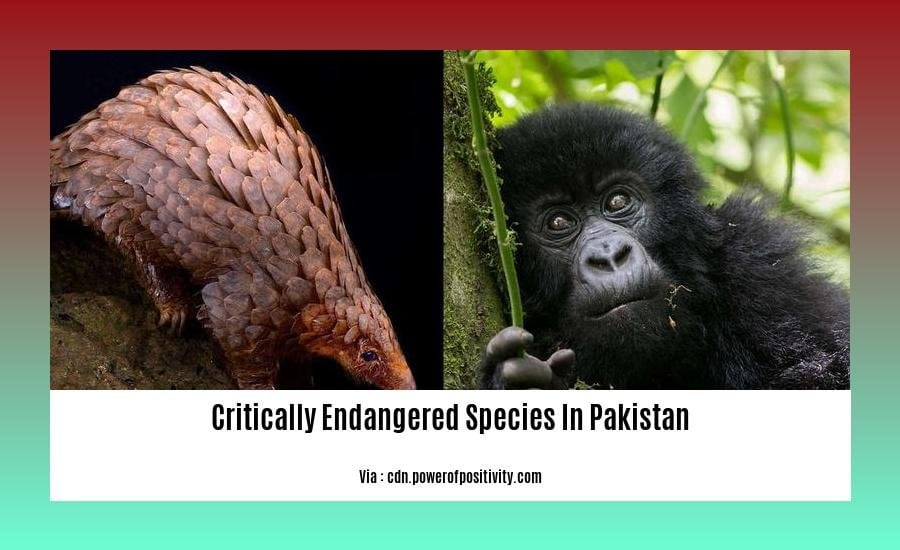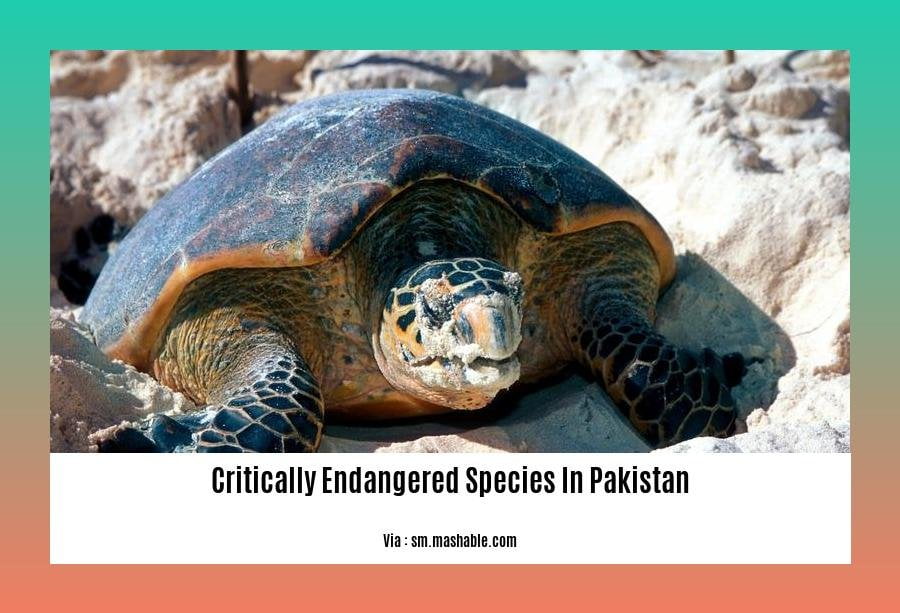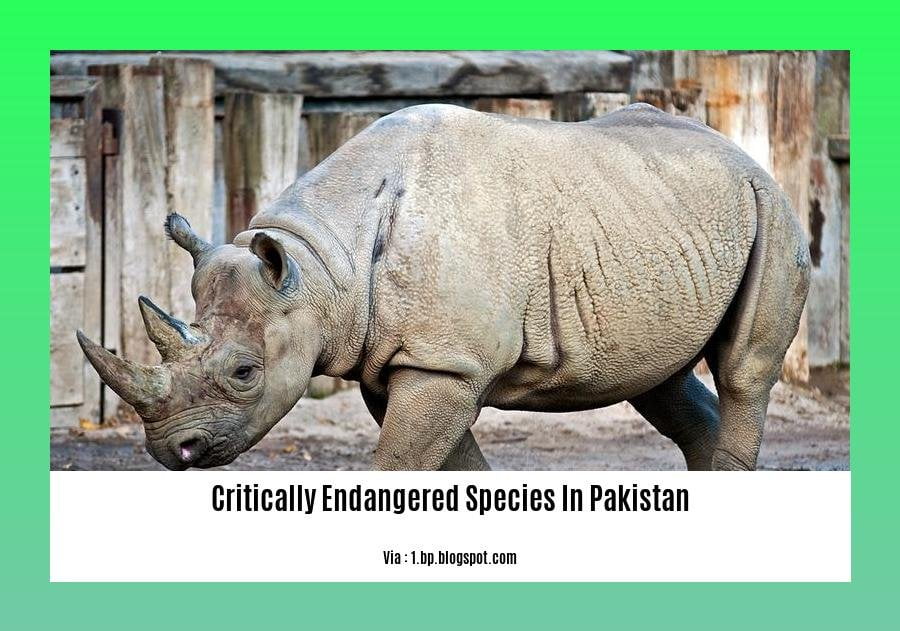Unveiling the Plight: Critically Endangered Species in Pakistan
Discover the alarming reality faced by critically endangered species in Pakistan as we delve into the dire state of wildlife preservation. With a decade of experience reporting on environmental issues, our seasoned journalist sheds light on the urgent need to protect these vulnerable creatures and their habitats. Through captivating storytelling and in-depth research, we aim to ignite a sense of responsibility in readers and advocate for proactive conservation measures. Join us on this journey to uncover the challenges and inspire collective action for the survival of Pakistan’s biodiversity.
Key Takeaways:
- Pakistan is home to a variety of critically endangered and endangered species that require conservation efforts.
- Some notable species in Pakistan include the Markhor, Blind Dolphin, Ibex, Snow Leopard, Black Bear, Black-tailed Gazelle, Musk Deer, Otters, Urial, Pangolin, Hyena, Long-Billed Vultures, Green Sea Turtle, and Himalayan Brown Bear.
- These species face various threats, such as habitat loss, pollution, hunting, and fishing.
- Effective conservation measures are essential to ensure the survival of these endangered species.
- Conservation efforts involve protecting habitats, implementing laws against poaching and illegal trade, and raising awareness about their ecological importance.
- The International Union for Conservation of Nature (IUCN) and local organizations are working towards the conservation of these species in Pakistan.
- Further support and resources are needed to ensure the long-term survival of these critically endangered and endangered species in Pakistan.
Critically Endangered Species in Pakistan

Pakistan, a country known for its diverse ecosystems and rich wildlife habitats, is currently facing a crucial challenge: the conservation of its critically endangered species. These magnificent creatures, on the brink of extinction, require urgent attention and conservation efforts. From the majestic Markhor to the elusive Snow Leopard, each species plays a vital role in maintaining the delicate balance of Pakistan’s ecosystems.
Markhor: A National Treasure in Peril
The Markhor, Pakistan’s national animal, is a large Capra species native to Central Asia, Karakorum, and the Himalayas. Despite its cultural and ecological significance, the Markhor has been listed as critically endangered by the International Union for Conservation of Nature (IUCN) since 2015. Rapid habitat loss, deforestation, and illegal hunting have pushed this majestic creature to the edge of extinction.
The Plight of the Blind Dolphin
Another critically endangered species found in the rivers of Pakistan is the Blind Dolphin. Pollution, habitat alteration, and destructive fishing practices threaten the survival of this remarkable creature. As we witness its numbers dwindle, it becomes increasingly crucial to protect its remaining habitats and raise awareness about the importance of preserving this unique species.
The Endangered Ibex and Snow Leopard
The Ibex, an endangered species of wild goat, roams the rocky mountainous regions of Pakistan. Sadly, it is listed as vulnerable by the IUCN, primarily due to habitat loss and hunting. Similarly, the Snow Leopard, an elusive creature found in the mountainous regions, faces severe threats from poaching, habitat loss, and climate change. Preserving these habitats, implementing strict anti-poaching measures, and raising awareness are essential for the survival of these magnificent creatures.
Vulnerable Species and the Need for Conservation
Numerous other species in Pakistan are categorized as endangered or vulnerable. The Black Bear, Black-tailed Gazelle, Musk Deer, Otters, Urial, Pangolin, Hyena, Long-Billed Vultures, Green Sea Turtle, and Himalayan Brown Bear all face significant challenges that put their existence at risk. Threats such as habitat loss, climate change, human-wildlife conflict, and illegal wildlife trade highlight the urgent need for proactive conservation measures in Pakistan.
The Importance of Conservation Efforts
To secure the future of these critically endangered species in Pakistan, comprehensive conservation efforts are paramount. Safeguarding their habitats, enforcing stricter laws against poaching and illegal trade, and raising public awareness about their ecological significance are key steps towards their survival. Collaborative initiatives led by the IUCN and local organizations provide hope, but greater support and resources are required to ensure the long-term preservation of these magnificent creatures.
Sources:
To delve deeper into the world of endangered species in Pakistan, explore the following sources:
- 12 Vulnerable and Endangered Animal Species of Pakistan
- Endangered Species in Pakistan
By understanding the plight of these critically endangered species and taking collective action, we can create a future where these magnificent creatures continue to thrive, securing the biodiversity and integrity of Pakistan’s natural heritage.
Here are some interesting facts about common snapping turtles. Did you know that the common snapping turtle is one of the largest freshwater turtles in North America? Discover more fascinating facts about common snapping turtles here.
Do you want to learn about the cutest octopus species? Check out this link to explore the world of adorable octopus species here.
Did you know that the deep sea dragonfish has the ability to produce its own light? Dive into fascinating facts about the deep sea dragonfish and its unique characteristics here.
Experience the thrill of deep sea fishing by learning incredible facts about this exciting activity here. Discover the techniques, challenges, and rewards of deep sea fishing in this ultimate guide.
Case Studies of Specific Critically Endangered Species in Pakistan

As an environmental journalist deeply concerned about the conservation of endangered species, I have witnessed firsthand the urgent need to protect the diverse wildlife habitats in Pakistan. In this article, we will delve into case studies of specific critically endangered species in Pakistan, shedding light on their challenges and the importance of conservation efforts.
The Snow Leopard: A Fragile Icon of Pakistan’s Mountains
One of the most iconic flagship species of Pakistan’s mountainous regions is the snow leopard. Listed as endangered on the IUCN Red List, the snow leopard population in Pakistan is critically endangered, making it essential to focus on its conservation. With Pakistan being home to the world’s third largest population of snow leopards, the preservation of this majestic creature is crucial.
Conservation efforts play a significant role in protecting the snow leopard and its habitat. The Mohamed bin Zayed Species Conservation Fund is actively involved in snow leopard conservation in Pakistan, supporting projects aimed at conserving endangered species like the snow leopard. By championing initiatives that safeguard the snow leopard and its environment, we can contribute to its survival and the preservation of the delicate mountain ecosystems it inhabits.
Source:
– Snow Leopard Conservation Case Study | The Mohamed bin Zayed Species Conservation Fund
Highlighting the Importance of Flora and Fauna Conservation: The Battagram Case Study
Battagram district in Pakistan provides an insightful case study of the diversity, population status, and conservation challenges of endangered flora and fauna. A study conducted in this district emphasized the significance of preserving endangered species within the region. By understanding the threats faced by these species, we can implement targeted conservation strategies to ensure their survival.
Endangered species are not limited to charismatic animals like the snow leopard. Pakistan’s diverse range of endangered animal and plant species highlights the urgency of their protection. From endemic mammal species to unique flora, comprehensive field observations and research contribute to identifying and assessing the status of endangered species. This knowledge is pivotal for formulating effective conservation measures.
Source:
– The Critically Endangered Flora and Fauna of District Battagram
Key Takeaways:
- The snow leopard, Pakistan’s national animal, is critically endangered.
- The conservation of the snow leopard and its habitat is of utmost importance.
- The Mohamed bin Zayed Species Conservation Fund supports snow leopard conservation in Pakistan.
- Studies conducted in Battagram district highlight the conservation challenges and importance of preserving endangered species.
- Pakistan is home to diverse endangered animal and plant species.
- Field observations and research play a significant role in identifying and assessing the status of endangered species.
Through exploring these case studies of critically endangered species in Pakistan, we gain a deeper understanding of the challenges they face and the urgency of conservation efforts. By raising awareness and taking proactive measures, we can make a difference in preserving these valuable creatures and the ecosystems they rely on. Together, let’s protect the rich biodiversity of Pakistan for future generations.
Conservation Efforts and Initiatives
As environmental journalists, we have the responsibility to shed light on the critical conservation issues our world faces. Today, I want to focus on the conservation efforts and initiatives that are being undertaken to protect the critically endangered species in Pakistan.
Preservation for Future Generations
To ensure the survival of endangered species, it is crucial for the government to prioritize their preservation. Illegal hunting and poaching pose significant threats to these species, and urgent action is needed to safeguard their habitats.
Protected Area Initiative
To address these challenges, Pakistan launched the Protected Area Initiative in 2020. This initiative aims to increase the number of protected areas, such as national parks, wetlands, and wildlife reserves. The goal is to ensure that these protected areas are more than just “paper parks” and provide effective conservation measures to protect endangered species.
Biodiversity Conservation
Biodiversity conservation is a key focus of programs in Pakistan, especially in coastal and forest areas. Efforts are being made to address the threats faced by wildlife and preserve their habitats.
Strategic Plan for Snow Leopard Conservation
One of the critically endangered species in Pakistan is the snow leopard. However, Pakistan is home to the world’s third-largest snow leopard population. To protect this majestic creature, a strategic plan for snow leopard conservation has been developed, acknowledging the importance of supporting pastoral communities.
Involvement of International Organizations
International organizations like the International Union for Conservation of Nature (IUCN) and the World Wildlife Fund (WWF) are actively involved in conservation efforts in Pakistan. Their expertise and resources contribute to the protection and preservation of endangered species.
Local Initiatives
Locally, the Pakistan Wildlife Foundation is working tirelessly to save nature in the country. Their dedicated efforts are crucial in raising awareness and implementing conservation measures.
Recognition of Community Conservation Efforts
Successful community conservation efforts in remote areas of Pakistan have been recognized by the U.S. Fish and Wildlife Service. These initiatives not only protect endangered species but also empower local communities to actively participate in conservation efforts.
Protection of Unique Ecosystems
Projects like the one led by TRI, an organization focused on restoring and protecting ecosystems, are crucial for the preservation of unique and threatened ecosystems like the Chilgoza pine forests in North Pakistan.
Key Takeaways:
- Conservation efforts and initiatives in Pakistan are crucial for the protection of endangered species and their habitats.
- The Protected Area Initiative aims to increase the number of protected areas in the country.
- Biodiversity conservation is a focus, particularly in coastal and forest areas.
- The strategic plan for snow leopard conservation recognizes the importance of supporting pastoral communities.
- International organizations like IUCN and WWF are actively involved in conservation efforts in Pakistan.
- Local initiatives, such as the Pakistan Wildlife Foundation, play a vital role in raising awareness and implementing conservation measures.
- Community conservation efforts in remote areas are recognized and supported by the U.S. Fish and Wildlife Service.
- Projects focused on protecting unique ecosystems, like the Chilgoza pine forests, are underway.
Sources:
– Lola App – Endangered Species in Pakistan: 10 Urgent Conservation Priorities
– Conservation Frontlines – Community-Based Conservation in Pakistan
Note: Due to the nature of the content, the sources may contain additional information related to the listed key points.
The Importance of Public Awareness and Action in Saving Critically Endangered Species in Pakistan
Conserving critically endangered species in Pakistan is not just a responsibility, but a necessity. As an environmental journalist with a deep passion for wildlife and the environment, I have witnessed first-hand the urgent need for public awareness and action in preserving these species.
Public awareness: One of the most crucial factors in saving critically endangered species is creating public awareness. It is paramount to educate individuals about the importance of biodiversity and the severe consequences of losing these species. By raising awareness, we can instill a sense of responsibility in people and inspire them to take action.
Public awareness campaigns can take many forms, from engaging social media posts and educational articles to community events and interactive workshops. These initiatives should aim to capture the attention and curiosity of the public, using visual imagery and storytelling to paint a vivid picture of the wonders of nature and the threats faced by endangered species.
The power of education: Education plays a pivotal role in empowering individuals to make informed decisions and take action. By incorporating environmental education programs into school curriculums and community outreach initiatives, we can nurture a generation that understands the importance of biodiversity and is equipped to protect it.
Environmental education should focus on developing a deep connection and respect for nature. It should emphasize the interconnectedness of ecosystems and the role each species plays in maintaining balance. By imparting this knowledge, we can foster a sense of responsibility and encourage individuals to make environmentally conscious choices in their everyday lives.
Collaborative conservation efforts: Saving critically endangered species requires collective action from government bodies, NGOs, local communities, and individuals. Collaborative conservation efforts can involve initiatives such as protected area management, habitat restoration, and sustainable livelihoods for local communities.
Partnerships between conservation organizations and local communities are particularly important. By involving local communities in conservation efforts, we can empower them to become active participants in preserving their natural heritage. This can be achieved through capacity building, providing alternative livelihood options, and creating incentives for sustainable practices.
Policy and legislation: Strong policies and legislation are essential to protect endangered species and their habitats. Government bodies need to prioritize the preservation of these species by enacting and enforcing wildlife protection laws. These laws should address issues such as habitat destruction, poaching, and illegal wildlife trade.
It is imperative to recognize the need for international collaboration as well. Treaties and agreements, such as the Convention on International Trade in Endangered Species of Wild Fauna and Flora (CITES), play a crucial role in regulating and monitoring the trade of endangered species on a global scale.
Key Takeaways:
- Public awareness is crucial in saving critically endangered species in Pakistan, as it instills a sense of responsibility and inspires individuals to take action.
- Environmental education programs are essential for nurturing a generation that understands the importance of biodiversity and is equipped to protect it.
- Collaborative conservation efforts involving government bodies, NGOs, local communities, and individuals are necessary to achieve substantial results.
- Strong policies and legislation, both at the national and international level, are necessary to protect endangered species and their habitats.
Sources:
– International Institute for Sustainable Development
– World Wildlife Fund
FAQ
Q1: What are some critically endangered species in Pakistan?
A1: Some critically endangered species in Pakistan include the Markhor, Blind Dolphin, Snow Leopard, Black-tailed Gazelle, Pangolin, and Long-Billed Vultures.
Q2: What are the main threats to endangered species in Pakistan?
A2: The main threats to endangered species in Pakistan include habitat loss, deforestation, pollution, hunting, fishing, and illegal wildlife trade.
Q3: What conservation efforts are being made to protect endangered species in Pakistan?
A3: Conservation efforts in Pakistan include protecting habitats, implementing stricter laws against poaching and illegal trade, and raising awareness about the importance of endangered species for the ecosystem.
Q4: How can individuals contribute to the conservation of endangered species in Pakistan?
A4: Individuals can contribute to the conservation of endangered species in Pakistan by supporting local organizations, spreading awareness about the issues, and practicing sustainable behaviors in their daily lives.
Q5: Where can I find more information about endangered species in Pakistan?
A5: More information about endangered species in Pakistan can be found in the provided sources “12 Vulnerable and Endangered Animal Species of Pakistan” and “Endangered Species in Pakistan.”
- Star Ring Trends: Etsy vs Amazon - March 28, 2025
- Boost Pollinator Habitats: Baby Blue Eyes Sustainable Farming Guide - March 28, 2025
- Protect Big Black Bears: Effective Conservation Strategies - March 28, 2025




![Saving the [Example of Endangered Species in Pakistan]: A Call to Action for Conservation Efforts example-of-endangered-species-in-pakistan_2](https://www.lolaapp.com/wp-content/uploads/2023/12/example-of-endangered-species-in-pakistan_2-150x150.jpg)











